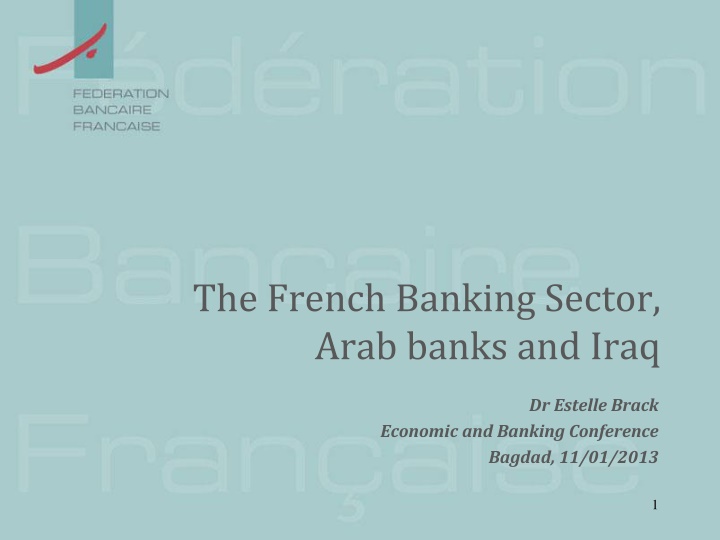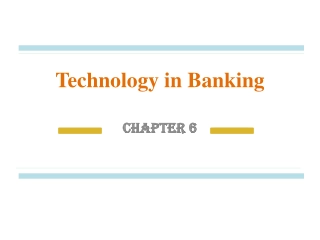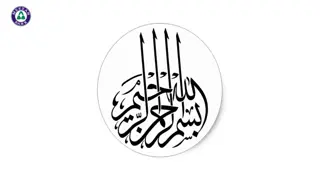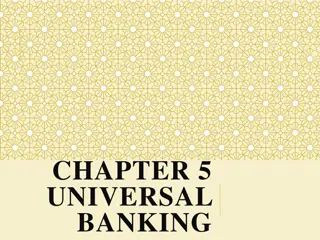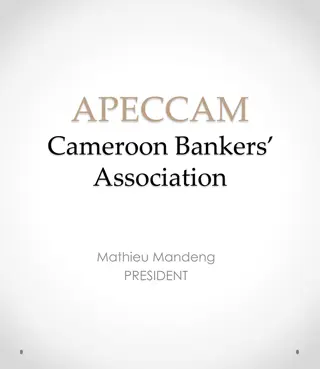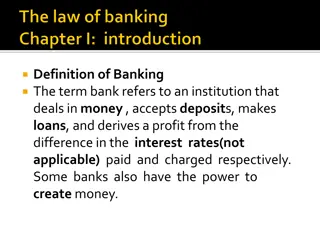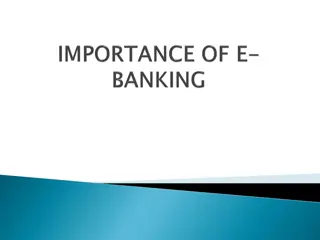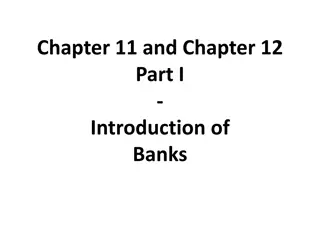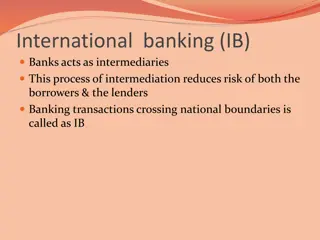Promoting French Banking Sector Development in Iraq
The IMF emphasizes the importance of modernizing Iraq's financial sector for economic growth. This article explores cooperation between Iraqi, French, and Arab banks to enhance financial services and attract foreign investment. Insights into the French banking system, regulatory framework, and potential strategies for promoting banking sector development in Iraq are discussed.
Download Presentation

Please find below an Image/Link to download the presentation.
The content on the website is provided AS IS for your information and personal use only. It may not be sold, licensed, or shared on other websites without obtaining consent from the author.If you encounter any issues during the download, it is possible that the publisher has removed the file from their server.
You are allowed to download the files provided on this website for personal or commercial use, subject to the condition that they are used lawfully. All files are the property of their respective owners.
The content on the website is provided AS IS for your information and personal use only. It may not be sold, licensed, or shared on other websites without obtaining consent from the author.
E N D
Presentation Transcript
The French Banking Sector, Arab banks and Iraq Dr Estelle Brack Economic and Banking Conference Bagdad, 11/01/2013 1
According to the IMF Iraq s reconstruction requires not only the rebuilding of its infrastructure, but also of its economic and social institutions and the creation of a business environment that attracts capital and brings with it new technology and skills to modernize the economy. IMF advice has centered on modernizing the financial sector to enable the private sector to develop , mainly by enhancing Central Bank of Iraq (CBI) operations and promoting a banking sector that can provide basic financial services, including, crucially, to the private sector. 2
How to promote a banking sector that can provide basic financial services, including, crucially, to the private sector ? There is a paragraph dedicated to financial service is the cooperation agreement signed a year ago between the Iraqi and French authorities One possibility often raised to me is to open foreign branches of European banks in Iraq to foster competition and, thus, develop financial integration. No doubt that the French banking sector has a good and rich experience (and best practices) to share, but that Arab banks are also appropriate stakeholders in that matter : they have local knowledge and they are already present. 3
The French banking system at a glance A stable & solid model Arab banks 4
The French banking system at a glance A stable & solid model Arab banks 5
The French banking system at a glance A single licence : under the so-called banking monopoly rule, banking services can only be offered on a regular basis by companies licensed as credit institutions. The rule has been set out by the Banking Act of January, 1984, as amended by the law of 16th July, 1992, implementing the Second European Union Banking Directive (December, 1989) and the law of 2nd July, 1996, implementing the EU Investment Service Directive (May, 1993). 6
The French banking system at a glance High quality of oversight and prudential supervision The new Prudential Control Authority (ACP - Autorit de contr le prudentiel) for Banking and Insurance activities The Banking and Financial Regulatory Committee (CRBF - Comit de r glementation bancaire et financi re) lays down the regulations governing credit institutions. The Financial Market Authority (AMF - Autorit des march s financiers) combined these three responsibilities (regulation, authorization and supervision) for investment services activities 7
The French banking system at a glance The Federation has very good relations with regulators and supervisors FBF is member of regulatory and supervisory committees (CECEI for example) as well as of self regulation bodies (CCSF - Consultative committee on financial services) Member of High Level Committees ad hoc like High Committee for Paris Financial Center High quality regular meetings with regulatory and supervisory bodies: Banque de France, ACP, AMF Is an involved stakeholder in the better regulation and consultation processes 8
The French banking system at a glance A comprehensive banking model Banking groups with diversified activities tailored to all customer segments Retail banking, investment banking and capital markets, asset management, payment instruments The system is dominated by five vertically integrated universal banks and their subsidiaries BNP Paribas, Soci t G n rale Three of the five are organized on a mutual basis (Cr dit Agricole, Cr dit Mutuel-CIC, BPCE) Two large financial institutions, La Poste and the Caisse des D p ts et Consignations (CDC), remain in government ownership. These groups control 83% of all assets 9
The French banking system at a glance Most of French banks belong to the universal banking model: diversification of business lines serves to better protect a universal bank against idiosyncratic shocks that adversely impact individual lines of business Domestic retail banking (households, corporates, SMEs), International retail banking, Specialised financial services (consumer credit, leasing, etc) Corporate and investment banking Asset management and conservation 10
The French banking system at a glance The French banks keep focused on the domestic retail market European and asian asset management of Societe Generale to Amundi in 2009 (SG 25%, CA 75%) Credit Agricole moved at the same time to domestic retail / proximity banking, which has remained Banque postale s and Credit Mutuel Group s long time strategy Reorientations announced recently by BNPP, SG and CA confirm this trend 70% of employees work in retail banking 11
The French banking system at a glance Fees represent on average 27.5% of revenues, including 75% on payments Funding remains the main job of French banks, and Revenues are thus very sensitive to refinancing costs 12
The French banking system at a glance Openess and global presence France is very open to foreign banks : 204 foreign credit institutions are established in France 106 foreign banking groups (branches or subsidiaries), among them 79% from OCDE countries and 61 financial companies Strong presence in investment banking Fewer in retail banking (HSBC, ING Direct) 166 French branches operating in the European Economic Area under the European Passport (106 in 2000) More than 400 French credit institutions (subsidiaries+ branches) operating outside the European Economic Area 13
The French banking system at a glance The French banking system currently accounts for 3-4%: banks contribution to GDP 48 million customers 76.8 million current accounts and 157 million savings accounts (148.5 million for households and 6.6 million for corporates) 39,000 bank branches (including 12,700 Banque Postale branches). 64 million bank cards, mostly debit cards which can be used for both payments and cash withdrawals through a nationwide network of POS terminals and ATM 14
The French banking system at a glance The banking industry has undergone major consolidation since the late 1980s (1/2) 1996: Cr dit Agricole and Indosuez, 1997: Soci t G n rale takes control of Cr dit du Nord, 1999: BNP Paribas Group is created, 2000: HSBC takes control of Cr dit Commercial de France 2002: Cr dit Agricole buys Cr dit Lyonnais (LCL) 2006: Natixis (Ixis Caisses d Epargne + Natexis BAnques Populaires) 2009: BPCE, a new group between Banques Populaires and Caisses d Epargne under the control of a holding company and owning Natixis 15
The French banking system at a glance The banking industry has undergone major consolidation since the late 1980s (2/2) Largest French banks revenues rose by 100% - 200% between 2001 and 2010 (Compass, 2011) : Mergers and acquisitions (47%) Organic growth Development of International activities (9%) Launch of new offers and evolution of tarification (12%) Evolution of refinancing costs (32%), which has had a significant influence the last years 16
The French banking system at a glance A stable & solid model Arab banks 17
A stable and solid model A mature retail banking market 98% of French residents over the age of 18 have a bank account ( Basic banking rights ) An average of 7 products per client Banks also offer insurance products Savings valorisation (second largest European market for collective investment fund) 18
A stable and solid model A cutting-edge industry (1/5) A high-technology industry: budgets earmarked for technological investments account for over 15% of bank overheads Very efficient card systems The top industry for card-based payments in Europe: 4 billion card- based payments per year and 120 million ATM withdrawals via 78.6 million bank cards in 2006 and 1.2 million payment points 19
A stable and solid model A cutting-edge industry (2/5) 453.4 billion transactions in France and abroad by 64.1 million French interbanking cards (Cartes Bancaires) among them 1,74 million electronic purses 19.1 billion euros transactions mainly in France with 24.4 million French private credit cards 25.7 billion euros transactions in France by interbanking or private foreign payment cards. According to the French Observatory for Payment Card Security, the fraud rate for payment cards is only 0.074% (2010) 20
A stable and solid model A cutting-edge industry (3/5) Main innovations have been integrated in banking in France Bankinsurance success for example illustrates this evolution : banks have a market share of 64% in life insurance, the highest figure for Europe after Portugal (88%) (Swiss Re SIGMA, 2007in Report Pauget-Constant) Remote banking has been developed on a multi-channel distribution model : 40% of the French population uses internet banking services, 19% by phone, compared to 30% and 14% on average in Europe (ECB, 2009) Direct banks only have 2% of market share in revenues (McKinsey & company, 2010). 21
A stable and solid model A cutting-edge industry (4/5) Numerous complex products A high-tec industry : more than 15% of general expenses are dedicated to technology investments A Strong Asset Management Pool: Paris is no. 2 in the world in assets under management. 22
A stable and solid model Cost-efficiency of the retail banking model (1/2) Revenues of retail banking in France per banked client is among the lowest : 1 in France, compared to 1,2 in Spain or 1,5 in Italy or in the UK (Bain, 2010 and Rapport Pauget-Constant) Branches per 1000 inhab and adviser per client : France is 35% above the european average. Financial adviser : 176 per 100,000 inhabitants whereas the European average is closer to 130 200 payment transactions by card, check, transfer or direct debit per year per client in France, 33% above the European average The cost of banking on the day-to-day basis to the volume of transactions is lower in France (0.7 EUR per transaction) than in whole Europe (0.8 EUR per transaction) 23
A stable and solid model Cost-efficiency of the retail banking model (2/2) Real estate credit is seen as an important way to gain new clients, and is consequently granted with very low margins. The interest rates are thus significantly lower than the European average The use of checks (22.5% of payment volumes) is free of charge, as well as withdrawals on ATMs within a banking group : this is a unique case in Europe 24
A stable and solid model Credit evolution based on economic fondamentals (1/2) Credit volumes granted by French banks have raised significantly for the past ten years x2 for Credit Mutuel and Societe Generale, x3 for BNP Paribas, x5 for Credit Agricole Based on corporate financing as well as individual clients 25
A stable and solid model US and European banks, including French banks, have gone through a exceptional crisis. France s financial system has shown resilience to severe market pressures but faces challenges French banks universal and diversified business model helped them weather the 2008 to 2009 financial crisis relatively well (IMF) All French banks are expected to easily meet the minimum Basel III requirement for common equity ratios. 26
A stable and solid model Since 2011, French banks moved swiftly to strengthen their solvency ratios and funding structures, largely through external deleveraging. French banks moved aggressively to strengthen their solvency ratios and funding structures through retained earnings and disposal of international non-core businesses. Reflecting the stability and profitability of the banks domestic operations as well as the changed operational and regulatory environment, deleveraging focused on foreign operations. It targeted mainly US dollar funded assets (such as trade and project financing), investment banking, and holdings of sovereign paper of higher-risk euro area countries. 27
A stable and solid model In contrast to banking sectors elsewhere, French banks were able preserve positive domestic credit growth (and low credit interest rates) through the whole crisis period (2008 to 2012). While lending standards may have been tightened given the slowdown of the economy, the overall softening of credit growth in 2012 is generally attributable to a shift in demand rather than supply. However, given ongoing balance sheet adjustments, domestic credit growth may be constrained in the event of an upswing in demand. Banks considered that the impact of their external deleveraging had been muted by the fact that other financial institutions were able to step in quickly into the areas vacated by them. 29
A stable and solid model Add ons for systemically important financial institutions (SIFIs) in France have not been disclosed by regulators, but standards are not expected to be the highest in Europe. Most French banks are therefore targeting higher capital ratios by retaining a large part of their earnings, starting in 2010. 30
The French banking system at a glance A stable & solid model Arab banks 31
Arab banks The Arab banking systems are relatively young They have undergone major improvements and developments during the last decade Arab banks are already regionally and internationally implemented Inside the Arab world, in Europe and the US, and more recently in Africa and Asia Banking in GCC countries vs banking in Mediterranean countries With a diversified model Retail banking, investment banking, Islamic finance 32
Arab banks A highly dynamic sector Arab banks grow faster than Gross Domestic Product +3,1% in 2011 +4,8% in 2012 +15% in Qatar +24% in Saudi Arabia +8% for Attijariwafa Bank (The World Bank) between 1S11 et 1S12 33
Arab banks The Arab banking systems have undergone the third phase of reform, leading to international integration And thus to a convergence towards international standards and practices Capital standards : Basel 2 and Basel 3 (BCBS) Risk management IFRS Governance and products adapted to emerging markets and economies Retail banking : ATM, card payments, etc / Mobile banking 34
Arab banks They share the same difficulties than other regions SMEs funding Financial inclusion Financial education They do Islamic banking, but in competition with conventional banking 34% of financial assets in Saudi Arabia vs 8% in Oman Less than 5% in Maghreb countries 35
Conclusion The French banking model has proven its particular resilience during the financial crisis. There are many French best practices which should empirically inspire the Iraqi reforms The French banks have entered a phase of consolidation, focused on their core business, retail banking and France/Europe The neighboring Arab banking systems are important sources of best practices and experiences in that matter No more one size fits all model but pick the best practices around the globe 36
